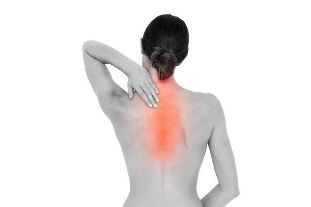
Osteochondrosis of the thoracic spine is often disguised as a pathology of internal organs. It is manifested by heart pain, shortness of breath, shortness of breath while breathing, and panic attacks. Therefore, the diagnosis of thoracic osteochondrosis is somewhat difficult. After its detection, conservative treatment is carried out using medication, physiotherapy, exercise therapy. With severe damage to the chest discs and spine, surgical intervention is required.
Brief description of the disease
Chest osteochondrosis is a degenerative-dystrophic disease of the spine. In the early stages of its development, the intervertebral discs are slowly destroyed. They become thin, fragile and radial cracks appear on their surface. In order to stabilize the thoracic segment affected by osteochondrosis, the bone tissue of the spine grows with the formation of acute formations - osteophytes. This causes severe restriction of mobility, compression of blood vessels and spinal roots.
Degrees ofpathology
The degree of osteochondrosis is a combination of symptoms characteristic of a certain radiographic stage. The more deformed the discs and vertebrae, the more pronounced the clinical manifestations. The severity of the pathology always determines the tactics of treatment, should be taken into account when choosing drugs and methods of their use.
I degree
X-ray images usually do not show any changes. But the intervertebral disc has already begun to break down due to the inability to retain moisture, which is essential for the recovery of its tissues. Sometimes there is a slight discomfort in the back that disappears quickly after a little rest. Grade 1 osteochondrosis is usually discovered accidentally at the time of diagnosis of other diseases.
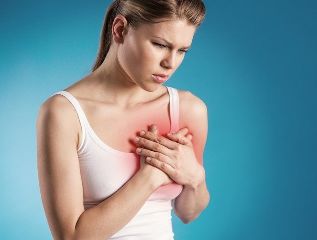
II degree
Thefiber ring becomes loose, fibrous. As one of the cracks grows on the surface of the disc, the nucleus pulposus extends there. On radiography, the distance between adjacent vertebral bodies is noticeable due to the reduction in disc height. As a result of the constant compensatory tension of the muscles, the mobility of the chest region is limited and moderate painful sensations occur.
III degree
The integrity of the annular fibrosis is violated, so the pulposus nucleus is distinguished from it. Herniated protrusions are formed - the main cause of severe symptoms and severe complications of thoracic osteochondrosis. The bodies of the spine are deformed, forming separate osteophytes. The pain in the chest becomes constant, the range of motion of the spine is significantly reduced.
IV degree
X-ray images clearly show the growth of connective tissue, the formation of multiple osteophytes. Adjacent vertebral bodies are blocked, immobilized. Radicular syndrome develops, often occurs discogenic myelopathy - spinal cord compression, dangerous for its irreversible consequences. A person barely serves himself in everyday life, loses the ability to perform professional duties.
Causes of Chest Spine Osteochondrosis
Chest osteochondrosis develops in people over the age of 40-45 due to natural aging of the body: slowing of recovery reactions, decreased collagen production, which leads to yoga elongation, density. At a young age, this occurs as a result of increased stress on the spine or against the background of pathologies already existing in the body:- Rheumatoid arthritis, systemic lupus erythematosus, scleroderma, ankylosing spondylitis;
- Endocrine and metabolic diseases, for example, diabetes, gout, hypothyroidism, hyperthyroidism;
- Congenital and acquired anomalies, including kyphosis, scoliosis.
Spinal cord injury, a sedentary lifestyle, and a lack of vitamins and micronutrients in the body can lead to premature destruction of the disc.
Characteristic signs and symptoms of the disease

Chest osteochondrosis develops gradually, without first revealing itself. It is in this process that his danger lies. The person gets mild pain and back discomfort for banal muscle fatigue at work, at home or in the garden after a hard day and does not seek medical help. Therefore, patients are usually diagnosed with a pathology of 2-3 degrees of severity, which is difficult to treat conservatively.
from the beginning
In the period of exacerbation, the pathology may manifest itself as pain between the shoulder blades, which arises when bending, turning the body. The range of motion is reduced and there are many specific signs of relapse.
Chest pain
In osteochondrosis, chest pain occurs first. They are not clearly localized, they can be given to the hands, throat bone, ribs. The pain in the heart is strong or moderate, resembles an angina attack and is not eliminated by taking nitroglycerin. Sometimes they are similar to the sensations that occur during the exacerbation of cholecystitis, pancreatitis. But unlike damage to the pancreas or gallbladder, pain is not accompanied by increased gas formation, heartburn, and swelling.
Chest tightness
Pain between the shoulder blades is sometimes accompanied by a feeling of shortness of breath during inhalation. The person is likely to be frightened, unable to understand the causes of this condition. Doctors advise us not to panic, but to sit down and measure your pulse. If the value obtained does not exceed 100 beats per minute, then the probability of lung or heart failure is very low.
Other symptoms
Gradually, the symptoms of osteochondrosis worsen with impaired sensitivity. There are numbness, tingling, creeping sensations. From time to time conditions arise that resemble panic attacks. They are characterized by fear, increased heart rate, excessive sweating and cold sweats. If these symptoms are accompanied by chest pain, then you need to take nitroglycerin and call your doctor. A similar set of symptoms may indicate a myocardial infarction.

The spinal roots, located in the chest area, irritate the internal organs. When they are irritated, compressed, the work of the gastrointestinal tract and liver is disrupted. Peristalsis is violated, epigastric pain, heartburn, itching occur.
Signs in the subacute stage
After exacerbation begins the subacute stage of the course of thoracic osteochondrosis. The pain and breathing problems persist, but they are much less intense. A person for a long time no longer seeks a comfortable state of the body in which pain is not felt. The duration of the subacute stage is up to two weeks. All medical recommendations are followed by remission, which is characterized by the absence of pronounced symptoms. Disruption of the regimen leads to a new exacerbation of osteochondrosis.
Remission
In the remission stage, slight discomfort may be observed during weather changes or hypothermia. Acute pain occurs only in osteochondrosis of 2-4 degrees of severity, due to very sharp twisting or tilting of the body. Exacerbation of chronic pathologies, stress, physical activity, and prolonged stay in one state of the body can lead to another relapse.
Principles of disease diagnosis
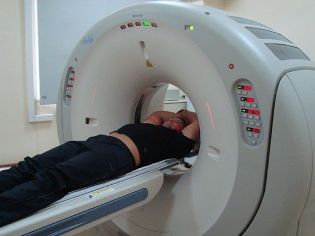
The neurologist makes the primary diagnosis based on the patient's complaints, medical history. On external examination he finds spots in the chest region where pressure is applied with pain. Conducting functional tests allows you to assess the safety of reflexes, to detect sensitivity disorders. The most informative of the instrumental methods is radiography. But for a detailed examination of the spinal segment a CT, MRI can be performed. To rule out diseases of the cardiovascular system, patients are given an ECG.
First aid for exacerbations
Pain in the recurrence of thoracic osteochondrosis is acute, pervasive, so a person needs first aid. It should be relaxed, laid on a solid surface, covered with a warm blanket. If relapse is accompanied by increased heart rate, shortness of breath, increased anxiety, then you should call your doctor. Any nonsteroidal anti-inflammatory drug can be taken to relieve pain between the shoulder blades.
How to treat chest osteochondrosis
Only an integrated approach to treatment will eliminate all the symptoms of osteochondrosis, slow down or stop its spread to healthy discs and vertebrae. With pathology of severity 1-2 degrees, conservative methods of therapy are used. For osteochondrosis 3-4 degrees, it is typical to form large hernias. Surgical treatment may be needed to relieve pressure on the blood vessels and spinal cord.
Preparation
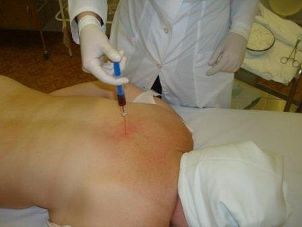
Various clinical and pharmacological group drugs are used in the treatment of chest osteochondrosis. Initially, parenteral administration agents are usually used to rapidly provide a therapeutic effect. After a few days, the injectable solutions are replaced with safer tablets, ointments and plaster.
Nonsteroidal anti-inflammatory drugs (NSAIDs)
Nonsteroidal anti-inflammatory drugs have a pronounced analgesic, anti-inflammatory, anti-inflammatory action. Intramuscular infusion of the solution allows to stop acute pain. Topical remedies are used to eliminate mild discomfort between the shoulder blades. For moderate pain, nonsteroidal anti-inflammatory drugs are well tolerated when taken orally.
Muscle relaxants
Muscle relaxants are used to relieve muscle spasms in response to severe pain. Most often, treatment of chest osteochondrosis begins with intramuscular administration of medications that, in addition to muscle relaxant tolperisone, contain an anesthetic.
Chondroprotectors
Taking a course of chondroprotectors in grade 1 pathology helps to repair damaged discs. In other cases, they are prescribed to improve metabolism in the affected segment of the spine to prevent disease progression.
B group vitamin preparations
Their use helps to increase blood flow, improve the functioning of the peripheral nervous system, restore trophism and innervation. The B vitamin complex has a beneficial effect on degenerative diseases of the nerves and musculoskeletal system.
Physiotherapy exercises
In case of grade 1 osteochondrosis of the chest, daily exercise therapy allows you to do it without the use of medication. Healing occurs by strengthening the muscles, improving the blood supply to the tissues with nutrients. In other cases, exercise and regular exercise prevent the involvement of healthy segments of the spine in the destructive process and prolong the remission phase.
Complex from a standing position
The following therapeutic exercises are the most therapeutically effective in thestanding position:
- Place your shoulders on your shoulders, lean forward, and lift your bent legs as if you were reaching the opposite knee with your elbow;
- Raise your left hand up, lean to the right. Perform exercises in the opposite direction;
- Spread your legs shoulder width apart, spread your arms. Lean forward, touch the opposite foot with the palms.
The number of repetitions is 10-12 times in 2-3 sets.
from a prone position
For this workout you will need a gym or a thick, double-folded blanket:
- Lie on your stomach, raise your arms and legs at the same time;
- Lie on your back, lift your upper body, stretch your arms and legs;
- Lie on your back, bend one leg, bring the other back and try to touch the floor with your knee.
Each exercise should be done 7-10 times.
Session
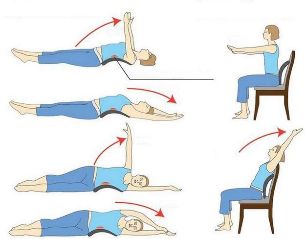
Sharp, high-amplitude movements, including rolling, should be avoided when performing such exercises:
- is sitting on the floor, leaning forward and trying to touch the opposite foot with his palms;
- Sitting on a chair or stool, stretch your arms forward and slowly turn from side to side;
- When sitting on the floor, put your hands on your knees, pull your chest as close as possible.
Exercises in the first lessons should be repeated 5-7 times, after about a month - 15-20 times.
Physiotherapy
Magnetic therapy, laser therapy, UHF therapy, sinusoidal currents, shock therapy, paraffin and ozokerite are used to treat osteochondrosis of the chest. In case of exacerbation, electrophoresis, ultraphonophoresis with glucocorticosteroids, anesthetics, B vitamins, chondroprotectors are performed.
massage
Massage performed by a specialist helps to eliminate pain between the shoulder blades, to relax the spasmodic skeletal muscles.
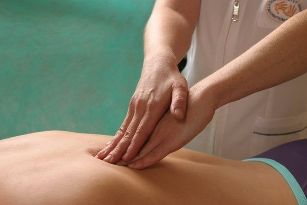
In osteochondrosis, all types of massage are therapeutically effective - classical, vacuum, acupuncture, connective tissue. Self-massage at home is conveniently done using a wooden or electric long-hand massager.
Acupuncture
Acupuncture is a method of treating pathology by inserting needles into bioactive points of the human body. They are thin, short, so sometimes only slight discomfort occurs during skin piercing. But this effect is also enough to produce substances with analgesic and anti-inflammatory action in the body.
Meal
On the recommendation of nutritionists, patients with thoracic osteochondrosis should avoid fatty meats, rich soups, smoked meats, homemade and factory-made marinades. It is necessary to limit the amount of salt in the diet, which leads to edema. Every day you should drink about 2. 5 liters of fluid - water, vegetable juices, berry fruit drinks, fruit compotes.
Folk remedies
Neurologists are allowed to use decorations and infusions containing herbs, ointments, alcohol and oils after basic therapy. Folk remedies are used to relieve mild pain between the shoulder blades, which sometimes arises after physical exertion.
Celery root
Peel a large celery root, press finely, squeeze the juice. Add 100 g of chopped fresh celery. Take 3 tablespoons 4 times a day with meals to cleanse the spinal structures from harmful salt deposits.
Sunflower root
Pour a teaspoon of dry crushed sunflower roots in a glass of hot water. Bring to a boil, simmer for 20 minutes, cool under the lid, drain. Drink 3-4 times a day.
Home ointment

Grind gum syrup and a teaspoon of thick honey in a mortar, add 2 drops of juniper, rosemary, eucalyptus essential oils. Make 100 g of oil jelly in small portions. Stir, transfer to a jar, store in the refrigerator, massage from the back pain.
During pregnancy
Systemic analgesics are contraindicated during pregnancy, so neurologists prefer to use drugs externally - ointments, gels, varnishes. If you can not do without taking pills, then their doses are significantly reduced. The main methods of therapy for osteochondrosis of the chest during childbirth are massage and exercise therapy.
Possible consequences
In the absence of medical intervention, thoracic osteochondrosis can lead to pneumosclerosis, arrhythmias, vegetative-vascular dystonia, deterioration of the gastrointestinal tract, impaired sexual and reproductive function in women and men.
Prevention and prognosis
The prognosis is favorable for timely detection of the disease, competent, comprehensive treatment. If complications of thoracic osteochondrosis have developed, then only following all medical recommendations will allow you to achieve stable remission.
As a prevention of pathology, neurologists advise not to exclude its causative factors from the normal way of life. These are excess weight, low physical activity, deficiency of vitamins and minerals, excessive stress on the spine.














































